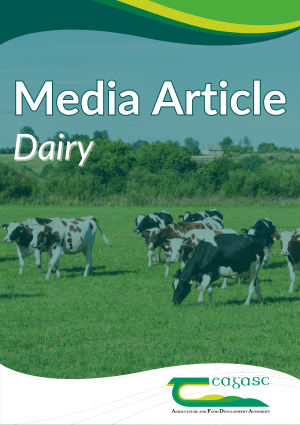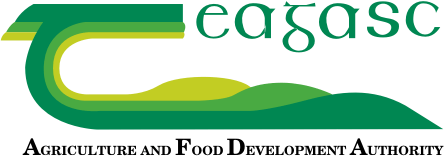
Utilising the CBV to purchase your 2025 Dairy-Beef Calves
Utilising the CBV to purchase your 2025 Dairy-Beef Calves 16 December 2024 Type Media Article By Niall Mullin, B&T Drystock Advisor, Teagasc Galway/Clare As the agricultural industry continues to evolve, the use of new technologies is crucial for beef farmers looking to increase profitability on farm. While 2024 has provided record beef prices, input costs […]
By By Niall Mullin, B&T Drystock Advisor, Teagasc Galway/Clare

Utilising the CBV to purchase your 2025 Dairy-Beef Calves
Type Media Article
By Niall Mullin, B&T Drystock Advisor, Teagasc Galway/Clare
As the agricultural industry continues to evolve, the use of new technologies is crucial for beef farmers looking to increase profitability on farm. While 2024 has provided record beef prices, input costs still remain relatively high compared to pre-covid figures. One such innovation is the Commercial Beef Value (CBV) which helps both dairy and beef farmers make informed decisions when purchasing calves from the dairy herd.
With many beef farmers purchasing calves in early 2025, the usual assessments of appearance of calves to ensure they are healthy, alert and of good size for their age are still important. However, how often do we see two similar calves of the same age, from the same source farm and reared to slaughted in the exact same system only for them to have very different levels of performance. Here is where the CBV can help you out.
What is the CBV?
The CBV is a tool that gives an insight into the genetic merit of an animal that is destined for beef production based on its parentage. It takes into account five key beef production traits: carcass weight, feed intake, carcass fat, carcass conformation and docility. This allows you to identify calves that are faster growing, will have better conformation, be more feed efficient and also more docile. In order for a CBV to be generated for a calf they must have a sire recorded when registered. Purchasing calves with no sire recorded leaves you in the unknown as to the genetic background of that animal.
How is the CBV expressed?
The CBV is expressed as a euro value similar to the EBI and Euro-star indexes currently in place. The higher that euro value is, the greater genetic merit potential that animal has. Animals are assigned to one of three different breed types: beef x beef; beef x dairy; and dairy x dairy. This is important as it ensures that dairy/beef animals are not being compared to beef animals from the suckler herd for example. Animals are then assigned a star rating from one to five which farmers will be familiar with by now. Five star animals are in the top 20% of the national population for that breed type, with one star animals being in the bottom 20%. The table below shows the threshold CBV values for each star rating and animal type which will be useful for farmers to use when purchasing calves.
|
ICBF |
CBV Star-rating Percentiles* |
||||
|---|---|---|---|---|---|
|
Stars |
** |
*** |
Average |
**** |
***** |
|
Across Breed |
€25 |
€93 |
€132 |
€185 |
€261 |
|
Suckler |
€204 |
€241 |
€255 |
€268 |
€296 |
|
Dairy x Beef |
€62 |
€82 |
€92 |
€102 |
€133 |
|
Dairy x Dairy |
-€23 |
-€7 |
-€1 |
€5 |
€20 |
Table 1: The CBV star-rating percentiles – *Based on the March 2024 Evaluation
What this means is that if you are considering purchasing two dairy x beef calves, one with a CBV of €120 and the other has a CBV of €45. The calf with a value of €120 should deliver €75 extra profit than the lower value calf through increased carcass weight and conformation, better feed efficiency, etc. The higher value animal may also be slaughtered at an earlier date which reduces costs also.
What research has been done to date?
Research has been conducted at the Teagasc research centre in Grange, and is still ongoing. One trial compared how Angus steers – both of high and low CBV- performed under a grass based system. This trial undertaken by Dr Nicky Byrne and many others, found that every €1 increase in the CBV of Angus type steers, resulted in an extra €1.85 net profit. The trial also compared a housed finishing strategy versus animals being finished at grass with the results outlined below.
|
|
Conventional (housed) |
Supplemented at grass |
||
|---|---|---|---|---|
|
Animal type |
High CBV Angus |
Low CBV Angus |
High CBV Angus |
Low CBV Angus |
|
Finishing age (days) |
641 |
652 |
603 |
601 |
|
Carcass weight (kg) |
314 |
306 |
310 |
284 |
|
Carcass conformation |
O=/O+ |
O= |
O+ |
O= |
|
Carcass fat |
3+/4- |
3+ |
4- |
3+ |
|
Finishing period outdoors and indoors (days) |
51 |
62 |
101 |
99 |
|
Finishing supplement (kg) |
248 |
306 |
403 |
403 |
|
Lifetime ADG (kg) |
0.91 |
0.88 |
0.92 |
0.86 |
Table 2: Teagasc Grange CBV research on Angus steer performance per feed management strategy and CBV rating.
The high CBV steers were capable of being finished both indoors or outdoors before winter housing while being supplemented with concentrates at grass. However, the low CBV Angus steers achieved carcass fatness quickly but produced lower carcass weights which resulted in a reduction in farm profitability. These animals provide less flexibility as they need to be allowed grow at a slower rate at pasture to develop their frame and then fed in a short 60-day finishing period. With the need for reduced age at slaughter to reduce agricultural emissions and increase profitability, low CBV animals will not meet this criteria. The high CBV steers also had better carcass traits with 75% of them meeting overall carcass specifications compared to 52% of the low CBV Angus steers.
Take-home messages
- Higher CBV animals are more efficient, have an increased carcass value and have a higher chance of meeting carcass specifications.
- Consult with the farmer you are buying your calves off to get a list of each animals CBV when selecting your calves to purchase as they are only available on the herd owners ICBF account.
- The beef merit of calves can vary significantly within the same breed so don’t purchase calves solely based on how they look on the day.
- Genotyped animals being traded through marts will have their CBV displayed on mart boards so ensure you take this into account if purchasing through the marts.
